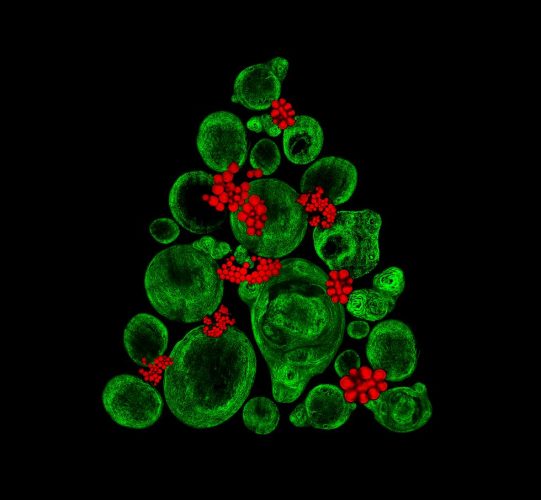Stain-less laser-based imaging used for regenerative medicine research
Posted: 11 January 2019 | Dr Zara Kassam (Drug Target Review) | No comments yet
Researchers create images from stem cells as part of an investigation into new optical techniques to monitor the cells’ development…


Researchers have created seasonal images from stem cells using innovative laser-based imaging techniques used as part of a regenerative medicine research programme.
University of Southampton postgraduate researcher Catarina Moura is working with skeletal biologists at Southampton General Hospital to investigate new optical techniques to monitor the development of the cells – in this case, to create and grow cartilage from human stem cells.
The green circular objects in the pictures are collagen cells and the red ‘dots’ are fat cells, both extracted from human bone marrow which Catarina has colour-enhanced electronically to bring out their detail. Normally, the collagen cells that appear green on Catarina’s tree and wreath images would be bluer in colour but, she says, the fat cells would certainly appear red with the lasers used.
“I’ve chosen green for the collagen fibres in my images because when you use the labelling technique typically you use a stain that fluoresces as green and, because a scientist would usually relate to that green colour when looking at labelled collagen fibres, I decided to use the same colour and create something more festive at the same time,” said Catarina.


“I’m working with Professor Richard Oreffo and Dr Rahul Tare from the University’s Centre for Human Development, Stem Cells and Regeneration who are trying to create and grow cartilage in the lab using a patients’ own (autologous) stem cells to then be implanted back into the patient if they have a cartilage defect,” she explains. “My part of the project is to develop and use techniques to make it easier monitor the development of the cells into cartilage in real time which is important to knowing if and when you can use it for the patient. If it’s successful, you can use the same cartilage to create the new tissue so it’s very important for us to get the monitoring right.”
Traditional techniques involve labelling or injecting the cells with stains or fluorophores – fluorescent compounds that ‘glow’ when exposed to light – to detect their intricate structures. Under the tutelage of her PhD supervisor, Southampton’s Sumeet Mahajan, Professor in Molecular Biophotonics & Imaging in Chemistry & Institute for Life Sciences (IfLS), Catarina is using ultra-fast lasers to achieve the same effect but in a less invasive way.
“Traditional techniques to detect whether the cartilage is developing can be disruptive and, in many cases, destructive,” said Catarina. “Our process has not been used before. What we are trying to do is introduce to biology techniques normally used in chemistry or physics, using inherent chemical or structural properties of the human stem cells. Currently, for validation we still need to do the standard exercises alongside our new techniques to be able to compare the two sets of results and, of course, using ultra-fast lasers we need to ensure that everything is optimised before it can go to the clinic, especially the exposure time.
“The massive advantage with our stain-less laser-based imaging approaches is that you can use the stem cell sample without having to interrupt the developmental process in real time, you don’t need to perform any cell disruption and there is no photobleaching (fading) which is fairly common with fluorescent material,” Catarina enthused. “Just put the bioengineered cartilage under the microscope and you have the image.”
Professor Richard Oreffo added: “Crucially, unlike current standard staining-based methods the stain-less imaging approach is translatable to the clinic as the stem cells are not harmed or disrupted in any way. Hence, the technology can be used to objectively assess development and screen stem cells to be absolutely sure before using them for therapy.”
Related topics
Label-Free, Regenerative Medicine
Related organisations
Southampton University
Related people
Dr Rahul Tare, Professor Richard Oreffo







